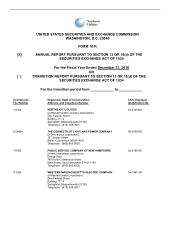Eversource 2010 Annual Report Download - page 21
Download and view the complete annual report
Please find page 21 of the 2010 Eversource annual report below. You can navigate through the pages in the report by either clicking on the pages listed below, or by using the keyword search tool below to find specific information within the annual report.
4
The following table shows the sources of 2010 electric franchise retail revenues for CL&P based on categories of customers:
Sources of
Revenue
% of Total
Revenues
Residential 61%
Commercial 32%
Industrial 6%
Other 1%
Total 100%
Rates
CL&P is subject to regulation by the Connecticut DPUC, which, among other things, has jurisdiction over its rates, accounting
procedures, certain dispositions of property and plant, mergers and consolidations, issuances of long-term securities, standards of
service, management efficiency and construction and operation of facilities. CL&P's present general rate structure consists of various
rate and service classifications covering residential, commercial and industrial services. CL&P's retail rates include a delivery service
component, which includes distribution, transmission, conservation, renewables, CTA, SBC and other charges that are assessed on all
customers.
The CTA is a charge assessed to recover stranded costs associated with electric industry restructuring as well as various IPP
contracts. The SBC recovers costs associated with various hardship and low income programs as well as payments to municipalities to
compensate them for losses in property tax revenue due to decreases in the value of electric generating facilities resulting directly from
electric industry restructuring. The CTA and SBC are annually reconciled to actual costs incurred, with any difference refunded to, or
recovered from, customers.
Under state law, all of CL&P's customers are entitled to choose their energy suppliers, while CL&P remains their electric distribution
company. Under "Standard Service" rates for customers with less than 500 KW of demand and "Supplier of Last Resort Service" rates
for customers with 500 KW of demand or greater, CL&P purchases power for those customers who do not choose a competitive energy
supplier and passes the cost to such customers through a combined GSC and FMCC on customers' bills. The combined GSC and
FMCC charges for both types of service recover all of the costs of procuring energy from CL&P's wholesale suppliers and are adjusted
periodically and reconciled semi-annually in accordance with the directives of the DPUC.
Although more CL&P customers chose competitive energy suppliers in 2010 than in 2009, CL&P continues to supply approximately 40
percent of its customer load at Standard Service or Supplier of Last Resort Service rates while the other 60 percent of its customer load
has migrated to competitive energy suppliers. Because this customer migration is only for energy supply service, it has no impact on
CL&P’s delivery business or its operating income.
Distribution Rates: On June 30, 2010, the DPUC issued a final order in CL&P’s most recent retail rate case approving annualized
distribution rate increases of $63.4 million effective July 1, 2010 and an incremental $38.5 million effective July 1, 2011. The 2010
increase was deferred from customer bills until January 1, 2011 to coincide with the decline in revenue requirements associated with
the final payment of CL&P’s RRBs. In its decision, the DPUC also maintained CL&P’s authorized distribution segment regulatory ROE
of 9.4 percent. In 2010, CL&P earned a distribution segment regulatory ROE of 7.9 percent, compared to 7.3 percent in 2009, and
expects to earn a distribution segment regulatory ROE of approximately 9 percent in 2011.
In May 2010, the Connecticut Legislature approved a state budget for the 2010-2011 fiscal year, which calls for the issuance by the
state of Connecticut of up to $760 million of economic recovery revenue bonds (ERRBs) that would be amortized over eight years.
These bonds will be repaid through a charge on the bills of customers of CL&P and other Connecticut electric distribution companies.
For CL&P, the revenue to pay interest and principal on the bonds would come from a continuation of a portion of its CTA, which would
have otherwise ended by December 31, 2010 with the final payment of the principal and interest on its RRBs, and the diversion of
about one-third of the annual funding for C&LM programs beginning in April 2012. A lawsuit pending against the DPUC to prevent the
issuance of the ERRBs is pending and several bills seeking to modify or prevent the issuance have been proposed before the state
legislature.
On March 31, 2010, CL&P filed with the DPUC an AMI and dynamic pricing plan concluding that a full deployment of AMI meters
accompanied by dynamic pricing options for all CL&P customers would be cost beneficial under a set of reasonable assumptions,
identified as the "base case scenario." Under the base case scenario, capital expenditures associated with the installation of the
meters are estimated at $296 million. CL&P has proposed beginning installation of meters in late 2012 and finishing in 2016.
CL&P has a transmission adjustment clause as part of its retail distribution rates, which reconciles on a semi-annual basis the
transmission revenues billed to customers against the transmission costs of acquiring such services, thereby recovering all of its
transmission expenses on a timely basis.
Sources and Availability of Electric Power Supply
As noted above, CL&P does not own any generation assets and purchases energy to serve its Standard Service and Supplier of Last
Resort Service loads from a variety of competitive sources through periodic RFPs. CL&P enters into supply contracts for Standard
Service periodically for periods of up to three years to mitigate price volatility for its residential and small and medium load commercial
























